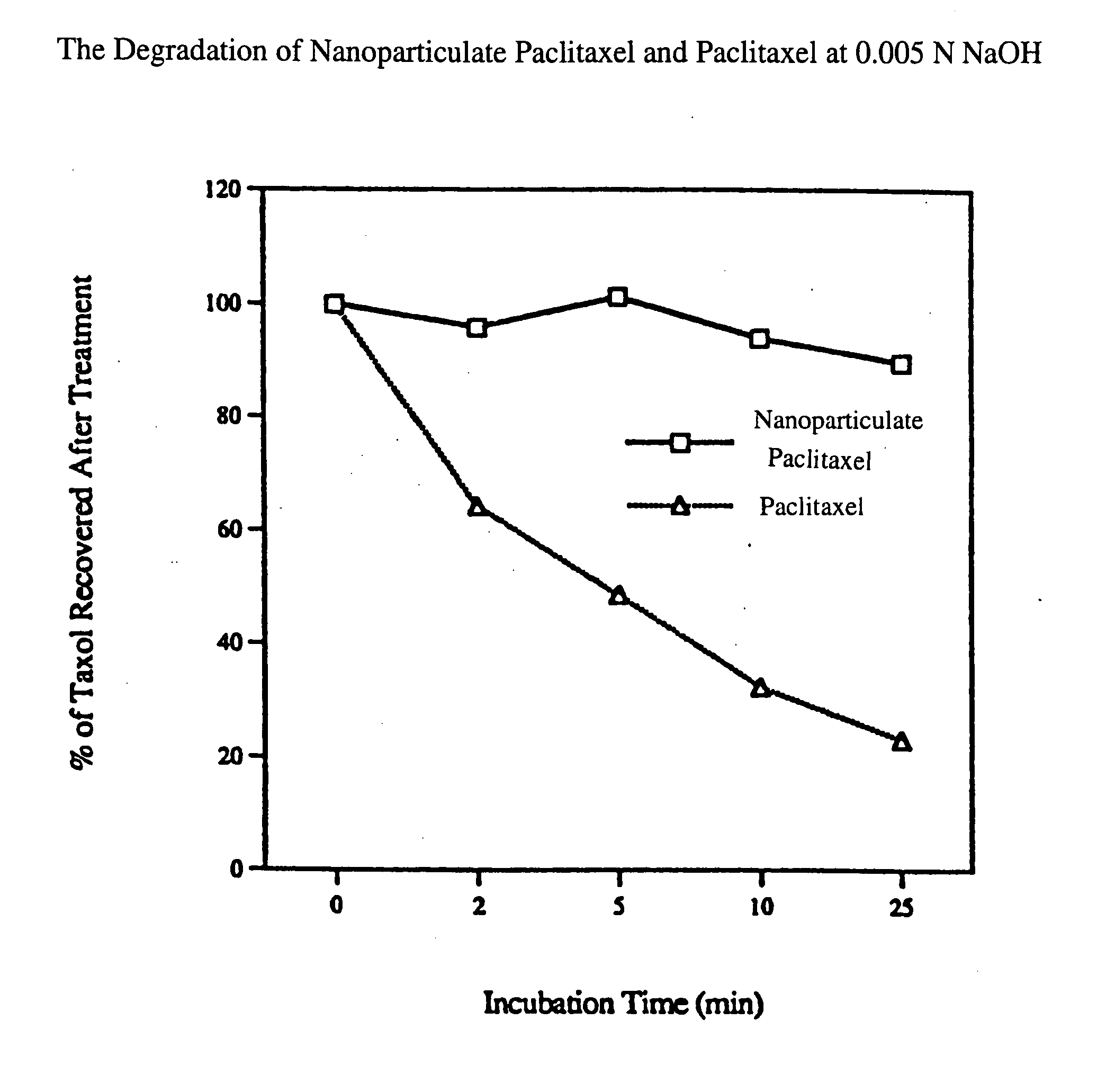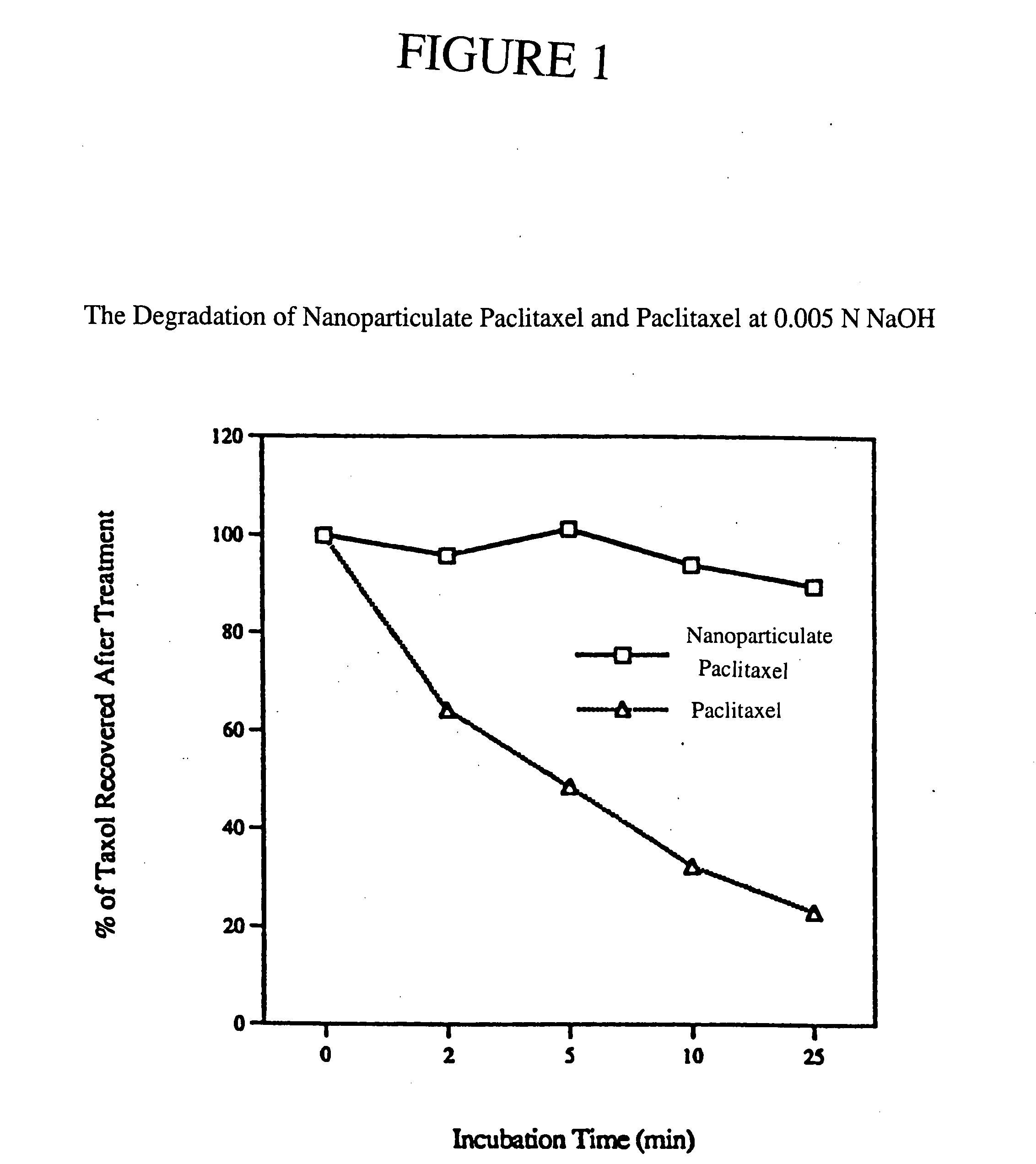Stabilization of chemical compounds using nanoparticulate formulations
a technology of chemical compounds and nanoparticulates, applied in the direction of antibacterial agents, drug compositions, immunological disorders, etc., can solve the problems of high undesirable chemical instability due to degradation or decomposition, shorten the effective shelf life of degradation, and reduce degradation efficiency, so as to achieve superior stability
- Summary
- Abstract
- Description
- Claims
- Application Information
AI Technical Summary
Benefits of technology
Problems solved by technology
Method used
Image
Examples
example 1
[0060] The purpose of this example was to determine the effect on the stability of paclitaxel of formulating the drug into a nanoparticulate composition.
[0061] Paclitaxel is a naturally occurring diterpenoid which has demonstrated great potential as an anti-cancer drug. Paclitaxel can be isolated from the bark of the western yew, Taxus brevifolia, and is also found in several other yew species such as T. baccata and T. cuspidata. Upon exposure to a basic pH (i.e., a pH of about 9), the drug rapidly degrades. Ringel et al., J. Pharmac. Exp. Ther., 242:692-698 (1987).
[0062] Two formulations of paclitaxel were prepared: a solubilized formulation of paclitaxel and a nanoparticulate formulation of paclitaxel. The degradation of paclitaxel for both formulations was then compared. For Formulation I, paclitaxel (Biolyse; Quebec, Canada) was solubilized in 1% methanol and 99% H2O to make a 2% paclitaxel solution. Formulation II was prepared by milling the 2% paclitaxel solution with 1% Plu...
example 2
[0065] The purpose of this example was to determine the effect on the stability of rapamycin of formulating the drug into a nanoparticulate composition.
[0066] Rapamycin is useful as an immunosuppressant and as an antifungal antibiotic, and its use is described in, for example, U.S. Pat. Nos. 3,929,992, 3,993,749, and 4,316,885, and in Belgian Pat. No. 877,700. The compound, which is only slightly soluble in water, i.e., 20 micrograms per mL, rapidly hydrolyzes when exposed to water. Because rapamycin is highly unstable when exposed to an aqueous medium, special injectable formulations have been developed for administration to patients, such as those described in European Patent No. EP 041,795. Such formulations are often undesirable, as frequently the non-aqueous solubilizing agent exhibits toxic side effects.
[0067] Two different formulations of rapamycin were prepared and then exposed to different environmental conditions. The degradation of rapamycin for each of the formulations...
example 3
[0074] The purpose of this example was to determine the effect of rapamycin concentration on the chemical stability of rapamycin in a nanoparticulate formulation following autoclaving.
[0075] Three rapamycin formulations were prepared by milling the following three slurries in a 250 ml Pyrex™ bottle containing 125 ml 0.4 mm Yttria-doped Zirconia media for 72 hours on a U.S. Stoneware roller mill: [0076] (a) 5% rapamycin / 1.25% Plurionic F68™[0077] (b) 5% rapamycin / 2.5% Plurionic F68™[0078] (c) 5% rapamycin / 5% Plurionic F68™
[0079] Each of the three dispersions was then diluted with water to prepare formulations having rapamycin concentrations of 4.4%, 2.2%, 1.1% and 0.5% as follows: [0080] (1) Formulation 1: a mixture of 4.4% rapamycin and, prior to dilution, 1.25% Plurionic F68™ in an aqueous medium; [0081] (2) Formulation 2: a mixture of 4.4% rapamycin and, prior to dilution, 2.5% Plurionic F68™ in an aqueous medium; [0082] (3) Formulation 3: a mixture of 4.4% rapamycin and, prior t...
PUM
| Property | Measurement | Unit |
|---|---|---|
| particle size | aaaaa | aaaaa |
| particle size | aaaaa | aaaaa |
| particle size | aaaaa | aaaaa |
Abstract
Description
Claims
Application Information
 Login to View More
Login to View More - R&D
- Intellectual Property
- Life Sciences
- Materials
- Tech Scout
- Unparalleled Data Quality
- Higher Quality Content
- 60% Fewer Hallucinations
Browse by: Latest US Patents, China's latest patents, Technical Efficacy Thesaurus, Application Domain, Technology Topic, Popular Technical Reports.
© 2025 PatSnap. All rights reserved.Legal|Privacy policy|Modern Slavery Act Transparency Statement|Sitemap|About US| Contact US: help@patsnap.com


